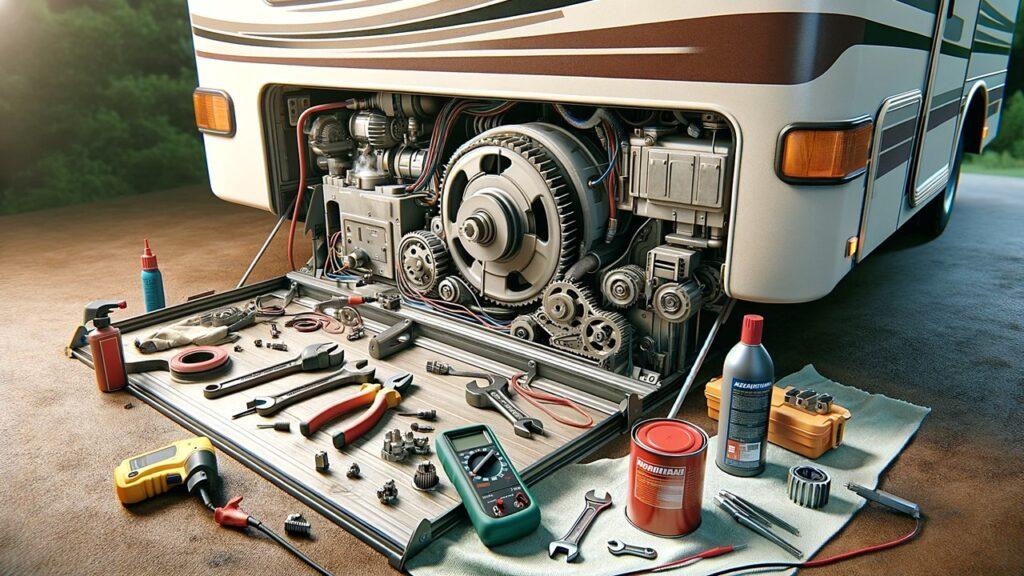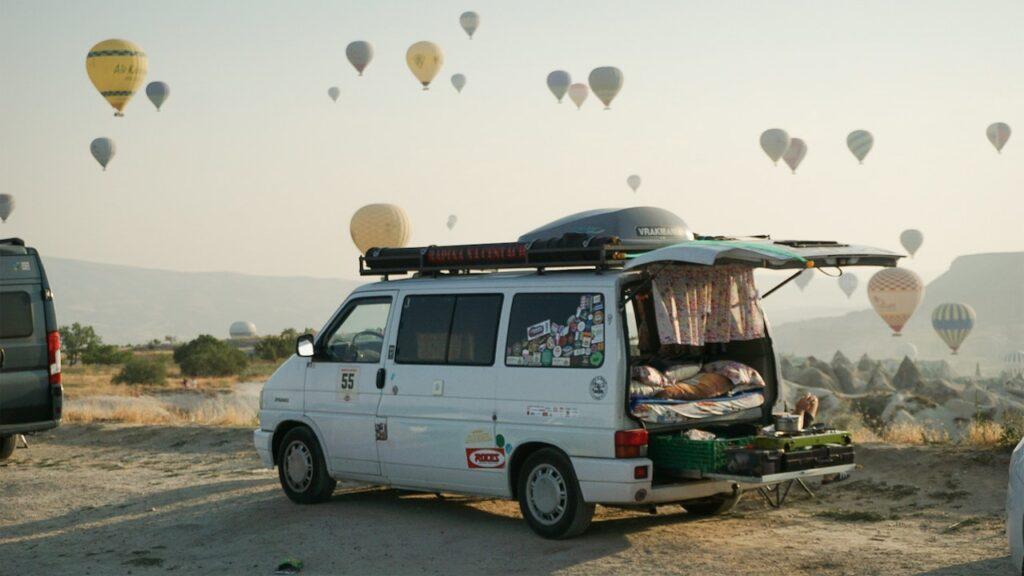
Ah, the open road calls, but what if your RV slide-out decides to act up? Slide-outs add space and comfort, but they’re not immune to problems, especially with the motors that power them. Don’t worry—we’re here to show you how to troubleshoot and fix RV slide-out motor issues.
From basic maintenance tips to easy repairs, this guide has you covered, so you can get back to enjoying smooth drives and hassle-free RV living. Let’s dive in and get your RV travel back on track!
What Are RV Slide Outs?
Imagine transforming a compact space into a roomy sanctuary with just the push of a button. That’s the magic of RV slide outs. These extendable parts literally slide out from the side of your RV, significantly expanding the living area.
They’re not just a luxury; they’re a game-changer in enhancing comfort and livability in your camper van or trailer. Slide outs make the RV experience more enjoyable, turning a simple vehicle into a spacious mobile home.
Why Do Slide Out Motor Issues Occur?
But what causes these indispensable features to falter? Slide out motors, like any component, are subject to wear and tear, especially after numerous journeys. Electrical faults can arise, often due to wiring issues or battery problems inherent in motorhomes.
Furthermore, poor maintenance can lead to unexpected failures. Regular upkeep and timely checks can significantly reduce the risk of these issues, ensuring your home-on-wheels remains functional and reliable.
Identifying Signs of Slide Out Motor Problems
Recognizing early signs of rv slide out motor problems can save you time, money, and stress on the road. Below are some common symptoms to look out for:
Buzzing Sounds: A travel trailer slide out motor buzzing without proper movement suggests internal motor problems, possibly due to overheating or worn components.
Unusual Noises: Grinding, clicking, or popping sounds when operating the slide-out may indicate issues with the motor, gears, or alignment. For example, a kz rv slide out clicking noise at full open could mean there’s debris in the tracks or a failing motor.
Slower Movement: If your rv slide out is moving slow or feels sluggish during extension or retraction, it could be due to worn-out components, lack of lubrication, or a weak rv slide motor. This might also suggest alignment or power issues.
Complete Failure to Operate: When your rv slide out won’t go out and the motor runs fine but gets hung up, or it doesn’t move at all, it’s often due to electrical issues like blown fuses, tripped breakers, or motor burnout.
Misalignment: Problems like rv slide out not closing evenly or the slide motor raising the bottom up when out or in can point to track misalignment. Misalignment puts unnecessary strain on the motor and can lead to premature wear.
Intermittent Functionality: A motor that starts and stops, such as in winnebago slide motor working intermittently, could be a sign of loose electrical connections, failing components, or even low power supply.
Motor Spinning Without Engagement: If the camper slide out motor is spinning but not engaging, it’s often a gear issue or damage within the motor assembly.
Electrical Clicking Without Movement: A slide motor clicking but not sliding out usually indicates electrical problems, such as corroded connections, low battery voltage, or a malfunctioning solenoid.
How To Troubleshoot Your RV Slide Out Motor Issues
Troubleshooting your rv slide out motor might feel intimidating, but with a clear step-by-step approach, you can resolve many issues on your own. Problems like rv slide out not working or slide motor clicking but not sliding out are common but often manageable with basic diagnostics. This guide will walk you through safety precautions, electrical and mechanical checks, and when to call in an expert.
Initial Inspection Steps
Before troubleshooting, prioritize safety and protect your RV from further damage. Follow these initial steps:
- Disconnect External Power: Ensure the RV is disconnected from shore power and that the battery is fully charged. A low or dead battery often causes rv slide out motor problems.
- Check for Obstructions: Inspect the slide-out mechanism for debris, leaves, or small objects that could block movement. This is especially critical for travel trailer slide out problems or when slide outs ratcheting sound not going out.
- Look for Visible Damage: Examine the wiring and connections near the slide-out system for signs of wear, corrosion, or breakage. Issues like rv hydraulic motor clicking can sometimes be traced to external damage.
Electrical Troubleshooting for RV Slide Outs
Electrical issues are one of the most frequent causes of slide out on rv not working. Start with these steps:
- Inspect Connections: Loose or corroded wires are common culprits. Use a wire brush or contact cleaner to secure and clean the connections. Issues like rv slide out clicks but doesn’t move are often electrical.
- Check Fuses and Breakers: Locate the RV’s fuse box and inspect the fuses for the slide-out system. Replace any blown fuses, and reset tripped breakers. This is a quick fix for rv slide out troubleshooting problems.
- Test the Motor Directly: If issues persist, test the motor by connecting it to a power source directly. This helps determine whether the problem lies in the motor itself or elsewhere in the system, such as in electrical problems with rv slides.
Mechanical Troubleshooting for Camper Vans
Once electrical systems are verified, move on to mechanical troubleshooting. Here’s what to do:
- Inspect Gears and Tracks: Look for broken teeth on gears or misaligned tracks. These can cause issues like rv slide out not closing evenly or momentum electric slide slows.
- Lubricate Moving Parts: Apply an RV-specific lubricant to tracks, gears, and pivot points. Proper lubrication resolves problems like rv slide out moving slow or slide out jams.
- Check for Alignment: Misalignment can lead to camper slide out motor spinning but not engaging. Adjust tracks or mounting bolts to ensure the slide-out operates smoothly.
When to Seek Professional Help
While many rv slide out motor problems can be resolved with DIY troubleshooting, some issues require professional expertise. Knowing when to call in a certified RV technician is crucial to prevent further damage. Here are situations where expert help is recommended:
- Complex Electrical Issues: Problems such as wiring connected to the slide out motor or issues with the control board often require specialized knowledge. If your rv slide out motor troubleshooting reveals deeper electrical faults, it’s best to consult an expert.
- Structural Damage: If your slide-out shows signs of misalignment or issues like travel trailer slide out not aligning properly with the frame, professional adjustments may be necessary. These problems can strain the motor and cause long-term damage if not fixed correctly.
- Persistent Motor Failures: If the rv slide out motor spins but doesn’t engage or continues to malfunction after testing and minor repairs, a professional inspection may be needed to identify hidden issues.
- Hydraulic Problems: For hydraulic-powered slide-outs, problems like fluid leaking or hydraulics not extending the slide properly may indicate internal damage or system failure that requires specialized tools to fix.
Expert Tip
If your initial troubleshooting doesn’t resolve the problem or if you encounter recurring issues, don’t hesitate to seek professional assistance. Addressing these concerns early prevents further damage and ensures your RV remains functional for all your adventures.
How To Fix Common RV Slide Out Motor Problems
When your RV’s slide-out starts acting up, it’s not just a minor inconvenience—it can feel like your entire mobile oasis is off-kilter. Fortunately, with some basic RV tool sets and a little know-how, most slide-out motor issues can be addressed right in your own ‘garage’. This step-by-step guide will help you diagnose and repair common problems, ensuring that your RV’s slide-out extends and retracts smoothly, keeping your adventures both comfortable and stress-free.
Step 1: Inspect Electrical Connections
Begin by thoroughly checking all electrical connections associated with your RV slide-out. Loose or corroded connections can often be the culprit behind malfunctioning motors. Secure any loose wires and clean off corrosion with a wire brush or contact cleaner. This simple fix can sometimes restore full functionality to your slide-out.
Step 2: Check and Replace Fuses and Circuit Breakers
Next, locate your RV’s fuse box and inspect any fuses linked to the slide-out system. A blown fuse can be a quick fix; replace it and test the slide-out again. Similarly, reset any tripped circuit breakers, which can often solve power issues without the need for further troubleshooting.
Step 3: Lubricate All Mechanical Components
Moving on to the mechanics, ensure that all parts of the slide-out, including tracks, gears, and pivot points, are well-lubricated. Use a lubricant specifically designed for RVs, which will help protect the components from excessive wear and environmental damage, prolonging their life.
Step 4: Test the Motor Independently
If the motor is still not operating correctly after checking the electrical and mechanical parts, try to test it independently by connecting it directly to a power source. This can help you determine whether the issue is with the motor itself or elsewhere in the system.
Step 5: Examine and Adjust Alignment
Misalignment can cause undue strain on the motor. Check that the slide-out is properly aligned according to your RV manufacturer’s guidelines. Adjustments may require loosening and retightening mounting bolts or screws in order to realign the slide-out for optimal operation.
Step 6: Replace the Motor if Necessary
Should the motor prove to be defective, replacing it may be the best option. Ensure you purchase a motor that matches the specifications for your RV model. Install the new motor, reconnect all components, and test the slide-out to ensure successful installation.
Step 7: Seek Professional Help When Needed
If at any point you feel out of your depth, or if the problem persists despite your efforts, it’s wise to seek professional assistance. Some issues may require specialized tools or knowledge that only a certified RV technician can provide.
Pro Tip: Regularly lubricate the slide-out tracks and check electrical connections to prevent common RV slide out motor problems.
How to Replace Faulty Slide Out Motor in RVs
Replacing a faulty RV slide out motor is a manageable task that can restore your RV’s functionality and save you from costly repairs. Follow these steps to safely and efficiently replace the motor:
Final Inspection: After testing, replace the motor cover securely. Confirm that all connections and components are stable to prevent future problems.
Ensure Safety First: Start by leveling your RV and disconnecting it from all power sources, including shore power and the battery, to prevent electrical accidents during the process.
Access the Motor: Locate the slide-out motor, which is typically covered by a protective panel or housing. Remove the cover carefully, as it is often secured with screws or bolts. Keep the screws in a safe place to avoid losing them.
Disconnect the Motor: Gently disconnect the motor from its mounting. This may involve detaching wires, gears, or brackets. Take note of how the motor is installed—consider taking photos or labeling parts to make reassembly easier.
Prepare the Replacement Motor: Ensure the new motor matches the specifications of your RV’s slide-out system. Compare it with the faulty motor to confirm compatibility before installation.
Install the New Motor: Reverse the steps you followed during disassembly. Secure the motor to its mounting, reconnect any wiring or brackets, and ensure everything is tightened properly.
Test the Slide Out: Once the new motor is in place, reconnect your RV to its power source and test the slide-out. Ensure it extends and retracts smoothly. If you notice issues like misalignment or unusual noises, double-check the installation and make adjustments as needed.
Repairing Electrical Issues in RV Slide Out Systems
Electrical problems are a common cause of RV slide out malfunctions, but they can often be resolved with a systematic approach. Follow these steps to identify and address electrical issues:
Test the System: After repairs, test the slide-out system to ensure smooth operation. If problems like rv slide out clicks but doesn’t move persist, further inspection may be required.
Inspect Wiring and Connections: Examine all visible wiring and electrical connections in the slide-out system. Look for frayed wires, corroded terminals, or loose connections that might disrupt power flow. Tighten any loose connections and clean corrosion using a wire brush or electrical contact cleaner.
Check Fuses and Circuit Breakers: Locate the RV’s fuse box and identify the fuses linked to the slide-out system. Replace any blown fuses and reset any tripped breakers. These are often simple fixes for issues like rv slide out not working or slide motor clicking but not sliding out.
Test the Power Supply: Ensure the battery is fully charged and supplying adequate power to the system. Low voltage can cause rv slide out motors to malfunction. Use a multimeter to confirm the voltage at key connection points.
Inspect the Control Board: If the issue persists, the problem might lie within the slide-out’s control board. Signs of malfunction include unresponsive motors or intermittent functionality. Refer to your RV’s manual for specific troubleshooting steps related to the control board.
Replace Damaged Components: If you find damaged wires, terminals, or other electrical components, replace them with compatible parts. Ensure all replacements meet the specifications provided in your RV’s manual to avoid further issues.
Maintaining Mechanical Components of RV Slide Outs
Preventive maintenance is key to avoiding future problems with your slide out system. Regularly clean and lubricate the slide out tracks and gears, using a lubricant suitable for RV use.
Check the alignment and adjust if necessary to ensure smooth operation. Inspect the seals around the slide out to prevent water damage and fix any leaks immediately. Keeping these components in good working order not only extends the life of your slide out but also enhances your overall RV camping experience.
Taking proactive steps to fix and maintain your RV slide out motor and its associated components not only saves you from future headaches but also ensures your home away from home remains spacious and comfortable, no matter where your travels take you.
With these tips, you can handle most issues that come your way and continue to enjoy the freedom and flexibility of RV living with confidence. Remember, a well-maintained RV is the key to stress-free adventures on the open road.
Regular Maintenance Schedule for RV Slide Outs
Adhering to a consistent maintenance routine can prevent many rv slide out problems. Here’s what to include:
- Inspect Mechanical Components Monthly: Check the rails, gears, and tracks for debris, wear, or damage. Keeping them clean and lubricated prevents issues like rv slide out moving slow or slide outs ratcheting sound not going out.
- Examine Electrical Systems: Inspect the wiring and motor for signs of wear, corrosion, or loose connections. Regularly replacing worn components can help avoid electrical problems with rv slides.
- Seal Maintenance: Clean the slide-out seals and apply a seal conditioner regularly. This prevents leaks and weather damage, which can lead to rv slide out not closing properly.
- Lubricate Moving Parts: Use a lubricant specifically designed for RVs on tracks, gears, and pivot points. This reduces strain on the motor and extends its lifespan.
Advantages of Timely Troubleshooting and Repairs
Staying proactive with rv slide out troubleshooting is not only cost-effective but also ensures smooth operation during your travels. Key benefits include:
- Extended Lifespan: Addressing small issues early prevents them from escalating into costly repairs, such as replacing slide-out motors or gears.
- Minimized Breakdowns: Timely repairs reduce the risk of unexpected failures like camper slide out motor spinning but not engaging while on the road.
- Peace of Mind: Knowing your slide outs are in optimal condition allows you to focus on enjoying your adventures without worrying about mechanical hiccups.
Which Maintenance Tasks Can RV Owners Do Themselves?
Many slide-out maintenance tasks are simple enough for RV owners to handle:
- Clean and Lubricate Tracks: Regularly clear debris from the tracks and lubricate them to prevent rv slide out jams.
- Check Alignment: Inspect the slide-out for proper alignment to avoid issues like rv slide out not square how to fix that. Adjust tracks or screws if needed.
- Inspect Electrical Connections: Look for frayed wires, corroded terminals, or loose connections. Replacing or tightening these can fix problems like rv slide out clicks but doesn’t move.
For more complex issues, such as slide motor failures or travel trailer slide pulls out side of camper fix, consulting a professional is the best course of action.
Wrapping It Up!
As we close the chapter on our comprehensive journey through the ins and outs of RV slide out motor issues, it’s clear that staying ahead with preventive maintenance isn’t just about avoiding hassles—it’s about enriching your RV experience. Whether you’re soaking up the sun by a lake or parked beneath the expansive starry sky, a fully functional slide out can transform your compact RV into a spacious retreat.
Grasping the nuances of your RV’s slide out system equips you to tackle small issues before they escalate. Timely interventions not only save you from potential disruptions during your adventures but also protect your investment in the long run. Moreover, by engaging in regular maintenance, you ensure smooth operations, which means more time relaxing and less time fixing.
We wholeheartedly encourage every RV owner to embrace the proactive approach to slide out maintenance. Regular checks, quick fixes, and an occasional professional tune-up can significantly enhance the reliability and functionality of your setup. After all, isn’t the joy of RV travel all about ease and comfort?
In summing up, remember that your RV is more than just a vehicle—it’s a home on wheels and your partner in the quest for new horizons. Well-maintained slide-outs are key to ensuring that home is as welcoming and reliable as possible, no matter where you roam. So, here’s to smooth travels and flawless functionality—may your road be open and your slide outs never stick!
Related FAQs
How Do I Diagnose Electrical Problems in My RV Slide Out?
Start by testing the fuse and circuit breaker, then check for loose or damaged wiring.
What Are The Signs That My RV Slide Out Motor Is Failing?
Common signs include abnormal noises, slower extension or retraction, and complete failure to operate.
Can Weather Affect My RV Slide Out Motor?
Yes, extreme temperatures and moisture can cause mechanical and electrical components to malfunction.
What Maintenance Can I Perform to Extend the Life of My RV Slide Out?
Regularly clean and lubricate the slide mechanisms, and inspect electrical components annually.
Where Can I Find Replacement Parts for My RV Slide Out Motor?
Replacement parts can typically be found through RV dealerships, specialty repair shops, or online RV parts suppliers.
As outdoor enthusiasts ourselves, we understand the significance of reliable gear that can withstand the elements and support you throughout your journey. We try to provide as much real life information with our guides and how tos to the readers as possible. Our honest and transparent reviews of essential outdoor gadgets and products are rooted in testing and experience. We take great satisfaction in offering unbiased evaluations, ensuring that you can make informed decisions when investing in outdoor gear. As an affiliate website, we may earn a small commission from some of the products we feature. However, rest assured that our opinions are not influenced by this, and your trust is always our top priority.



